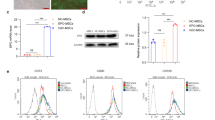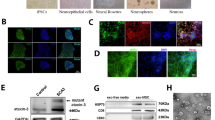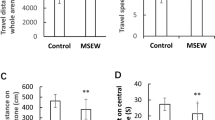Abstract
Mesenchymal stem cells (MSCs) can ameliorate symptoms in several neurodegenerative diseases. However, the toxic environment of a degenerating central nervous system (CNS) characterized by hypoxia, glutamate (Glu) excess and amyloid beta (Abeta) pathology may hamper the survival and regenerative/replacing capacities of engrafted stem cells. Indeed, human MSC (hMSC) exposed to hypoxia were disabled in (i) the capacity of their muscarinic receptors (mAChRs) to respond to acetylcholine (ACh) with a transient increase in intracellular [Ca2+], (ii) their capacity to metabolize Glu, reflected by a strong decrease in glutamine synthetase activity, and (iii) their survival on exposure to Glu. Cocultivation of MSC with PC12 cells expressing the amyloid precursor protein gene (APPsw-PC12) increased the release of IL-6 from MSC. HMSC exposed to erythropoietin (EPO) showed a cholinergic neuron-like phenotype reflected by increased cellular levels of choline acetyltransferase, ACh and mAChR. All their functional deficits observed under hypoxia, Glu exposure and APPsw-PC12 cocultivation were reversed by the application of EPO, which increased the expression of Wnt3a. EPO also enhanced the metabolism of Abeta in MSC by increasing their neprilysin content. Our data show that cholinergic neuron-like differentiation of MSC, their functionality and resistance to a neurotoxic environment is regulated and can be improved by EPO, highlighting its potential for optimizing cellular therapies of the CNS.
Similar content being viewed by others
Log in or create a free account to read this content
Gain free access to this article, as well as selected content from this journal and more on nature.com
or
Abbreviations
- Abeta:
-
amyloid beta
- ACh:
-
acetylcholine
- APPsw:
-
amyloid precursor protein Swedish mutation
- ChAT:
-
choline acetyltranferase
- CRD Fzd 7:
-
cystein-rich domain of frizzled 7
- DMEM:
-
Dulbecco's modified Eagle's medium
- EPO:
-
erythropoietin
- EPOR:
-
erythropoietin receptor
- EPI:
-
erythropoietin preincubation
- FCS:
-
fetal calf serum
- GLAST:
-
glutamate-aspartate transporter
- Glu:
-
glutamate
- GS:
-
glutamine synthetase
- H:
-
hypoxia
- HCs:
-
hypoxic conditions
- LDH:
-
lactate dehydrogenase
- LIF:
-
leukemia-inhibitory factor
- M1R:
-
muscarinic receptor subtype 1
- M1R-M3R:
-
muscarinic receptors of type 1–3
- MSCs:
-
mesenchymal stem cells
- N:
-
normoxia
- NCs:
-
normoxic conditions
- NeuN:
-
neuronal nuclei-specific protein
- NGF:
-
nerve growth factor
- PBS:
-
phosphate-buffered saline
- ROX:
-
carboxy-X-rhodamine
- TUNEL:
-
terminal deoxynucleotide transferase-mediated dUTP-biotin nick end labeling.
References
Kim SS, Yoo SW, Park TS, Ahn SC, Jeong HS, Kim JW et al. Neural induction with neurogenin1 increases the therapeutic effects of mesenchymal stem cells in the ischemic brain. Stem Cells 2008; 26: 2217–2228; e-pub ahead of print 10 July 2008..
Honma T, Honmou O, Lihoshi S, Harada K, Houkin K, Hamada H . Intravenous infusion of immortalized human mesenchymal stem cells protects against injury in a cerebral ischemia model in adult rat. Exp Neurol 2006; 199: 56–66.
Park HJ, Lee PH, Bang OY, Lee G, Ahn YH . Mesenchymal stem cells therapy exerts neuroprotection in a progressive animal model of Parkinson's disease. J Neurochem 2008; 107: 141–151; e-pub ahead of print 28 July 2008.
Pacary E, Legros H, Valable S, Duchatelle P, Lecocq M, Petit E et al. Synergistic effects of CoCl(2) and ROCK inhibition on mesenchymal stem cell differentiation into neuron-like cells. J Cell Sci 2006; 119: 2667–2678.
Webster NJ, Ramsden M, Boyle JP, Pearson HA, Peers C . Amyloid peptides mediate hypoxic increase of L-type Ca2+ channels in central neurones. Neurobiol Aging 2006; 27: 439–445.
Lassmann H, Reindl M, Rauschka H, Berger J, Aboul-Enein F, Berger T et al. A new paraclinical CSF marker for hypoxia-like tissue damage in multiple sclerosis lesions. Brain 2003; 126: 1347–1357.
Decker MJ, Jones KA, Solomon IG, Keating GL, Rye DB . Reduced extracellular dopamine and increased responsiveness to novelty: neurochemical and behavioral sequelae of intermittent hypoxia. Sleep 2005; 28: 169–176.
Theus MH, Wei L, Cui L, Francis K, Hu X, Keogh C et al. In vitro hypoxic preconditioning of embryonic stem cells as a strategy of promoting cell survival and functional benefits after transplantation into the ischemic rat brain. Exp Neurol 2008; 210: 656–670.
Tilleux S, Hermans E . Neuroinflammation regulation of glial glutamate uptake in neurological disorders. J Neurosci Res 2007; 85: 2059–2070.
Gonzalez FF, McQuillen P, Mu D, Chang Y, Wendland M, Vexler Z et al. Erythropoietin enhances long-term neuroprotection and neurogenesis in neonatal stroke. Dev Neurosci 2007; 29: 321–330.
Zhang J, Li Y, Cui Y, Chen J, Lu M, Elias SB, Chopp M . Erythropoietin treatment improves neurological funtional recovery in EAE mice. Brain Res. 2005; 1034: 34–39.
Ehrenreich H, Fischer B, Norra C, Schellenberger F, Stender N, Stiefel M et al. Exploring recombinant human erythropoietin in chronic progressive multiple sclerosis. Brain 2007; 130: 2577–2588.
Chong ZZ, Li F, Maiese K . Erythropoietin requires NF-kappaB and its nuclear translocation to prevent early and late apoptotic neuronal injury during beta-amyloid toxicity. Curr Neurovasc Res 2005; 2: 387–399.
Xue YQ, Zhao LR, Guo WP, Duan WM . Intrastriatal administration of erythropoietin protects dopaminergic neurons and improves neurobehavioral outcome in a rat model of Parkinson's disease. Neuroscience 2007; 146: 1245–1258.
Danielyan L, Mueller L, Proksch B, Kabisch D, Weller M, Wiesinger H et al. Similar protective effects of BQ-123 and erythropoietin on survival of neural cells and generation of neurons upon hypoxic injury. Eur J Cell Biol 2005; 84: 907–913.
Esneault E, Pacary E, Eddi D, Freret T, Tixier E, Toutain J et al. Combined therapeutic strategy using erythropoietin and mesenchymal stem cells potentiates neurogenesis after transient focal cerebral ischemia in rats. J Cereb Blood Flow Metab 2008; 28: 1552–1563.
Kemp CR, Willems E, Wawrzak D, Hendrickx M, Agbor Agbor T, Leyns L . Expression of Frizzled5, Frizzled7, and Frizzled10 during early mouse development and interactions with canonical Wnt signaling. Dev Dyn 2007; 236: 2011–2019.
Zwezdaryk KJ, Coffelt SB, Figueroa YG, Liu J, Phinney DG, LaMarca HL et al. Erythropoietin, a hypoxia-regulated factor, elicits a pro-angiogenic program in human mesenchymal stem cells. Exp Hematol 2007; 35: 640–652.
Robinson SR . Neuronal expression of glutamine synthetase in Alzheimer's disease indicates a profound impairment of metabolic interactions with astrocytes. Neurochem Int 2000; 36: 471–482.
de Hemptinne I, Vermeiren C, Maloteaux JM, Hermans E . Induction of glial glutamate transporters in adult mesenchymal stem cells. J Neurochem 2004; 91: 155–166.
Habler OP, Messmer KF . The physiology of oxygen transport. Transfus Sci 1997; 18: 425–435.
Harrison JS, Rameshwar P, Chang V, Bandari P . Oxygen saturation in the bone marrow of healthy volunteers. Blood 2002; 99: 394.
Dings J, Meixensberger J, Jager A, Roosen K . Clinical experience with 118 brain tissue oxygen partial pressure catheter probes. Neurosurgery 1998; 43: 1082–1095.
Tsang SW, Pomakian J, Marshall GA, Vinters HV, Cummings JL, Chen CP et al. Disrupted muscarinic M1 receptor signaling correlates with loss of protein kinase C activity and glutamatergic deficit in Alzheimer's disease. Neurobiol Aging 2007; 28: 1381–1387.
Caccamo A, Oddo S, Billings LM, Green KN, Martinez-Coria H, Fisher A et al. M1 receptors play a central role in modulating AD-like pathology in transgenic mice. Neuron 2006; 49: 671–682.
Henry-Feugeas MC . Alzheimer's disease in late-life dementia: a minor toxic consequence of devastating cerebrovascular dysfunction. Med Hypotheses 2008; 70: 866–875.
Hoogduijn MJ, Cheng A, Genever PG . Functional nicotinic muscarinic receptors on mesenchymal stem cells. Stem Cells Dev 2008; 18: 103–112.
Zhu X, Birnbaumer L . G protein subunits and the stimulation of phospholipase C by Gs-and Gi-coupled receptors: lack of receptor selectivity of Galpha(16) and evidence for a synergic interaction between Gbeta gamma and the alpha subunit of a receptor activated G protein. Proc Natl Acad Sci USA 1996; 93: 2827–2831.
Arien-Zakay H, Nagler A, Galski H, Lazarovici P . Neuronal conditioning medium and nerve growth factor induce neuronal differentiation of collagen-adherent progenitors derived from human umbilical cord blood. J Mol Neurosci 2007; 32: 179–191.
Walton RM, Wolfe JH . In vitro growth and differentiation of canine olfactory bulb-derived neural progenitor cells under variable culture conditions. J Neurosci Methods 2008; 169: 158–167.
Katoh M . WNT signaling in stem cell biology and regenerative medicine. Curr Drug Targets 2008; 9: 565–570.
Slevin M, Krupinski J, Mitsios N, Perikleous C, Cuadrado E, Montaner J et al. Leukaemia inhibitory factor is over-expressed by ischaemic brain tissue concomitant with reduced plasma expression following acute stroke. Eur J Neurol 2008; 15: 29–37.
Lim JH, Chun YS, Park JW . Hypoxia-inducible factor-1alpha obstructs a Wnt signaling pathway by inhibiting the hARD1-mediated activation of beta-catenin. Cancer Res. 2008; 68: 5177–5184.
Farías GG, Godoy JA, Hernández F, Avila J, Fisher A, Inestrosa NC . M1 muscarinic receptor activation protects neurons from beta-amyloid toxicity. A role for Wnt signaling pathway. Neurobiol Dis 2004; 17: 337–348.
de Boer J, Siddappa R, Gaspar C, van Apeldoorn A, Fodde R, van Blitterswijk C . Wnt signaling inhibits osteogenic differentiation of human mesenchymal stem cells. Bone 2004; 34: 818–826.
Bisaglia M, Venezia V, Piccioli P, Stanzione S, Porcile C, Russo C et al. Acetaminophen protects hippocampal neurons and PC12 cultures from amyloid beta-peptides induced oxidative stress and reduces NF-kappaB activation. Neurochem Int 2002; 41: 43–54.
Patel NS, Paris D, Mathura V, Quadros AN, Crawford FC, Mullan MJ . Inflammatory cytokine levels correlate with amyloid load in transgenic mouse models of Alzheimer's disease. J Neuroinflammation 2005; 11: 1–9.
Strunk T, Härtel C, Temming P, Matzke N, Zimmer J, Schultz C . Erythropoietin inhibits cytokine production of neonatal and adult leukocytes. Acta Paediatr 2008; 97: 16–20.
Kumral A, Baskin H, Yesilirmak DC, Ergur BU, Aykan S, Genc S et al. Erythropoietin attenuates lipopolysaccharide-induced white matter injury in the neonatal rat brain. Neonatology 2007; 92: 269–278.
Volmar CH, Ait-Ghezala G, Frieling J, Paris D, Mullan MJ . The granulocyte macrophage colony stimulating factor (GM-CSF) regulates amyloid beta (Abeta) production. Cytokine 2008; 42: 336–344.
Iwata N, Tsubuki S, Takaki Y, Shirotani K, Lu B, Gerard NP et al. Metabolic regulation of brain Abeta by neprilysin. Science 2001; 292: 1550–1552.
Colter DC, Sekiya I, Prockop DJ . Identification of a subpopulation of rapidly self-renewing and multipotential adult stem cells in colonies of human marrow stromal cells. Proc Natl Acad Sci USA 2001; 98: 7841–7845.
Schäfer R, Dominici M, Muller I et al. Progress in characterization, preparation and clinical applications of non-hematopoietic stem cells, 29–30 September 2006, Tubingen, Germany. Cytotherapy 2007; 9: 397–405.
Kern S, Eichler H, Stoeve J, Kluter H, Bieback K . Comparative analysis of mesenchymal stem cells from bone marrow, umbilical cord blood or adipose tissue. Stem Cells 2006; 24: 1294–1301.
Danielyan L, Lourhmati A, Verleysdonk S, Kabisch D, Proksch B, Thiess U et al. Angiotensin receptor type 1 blockade in astroglia decreases hypoxia-induced cell damage and TNF alpha release. Neurochem Res 2007; 32: 1489–1498.
Acknowledgements
The technical assistance by Mrs. Ursula Hermanutz-Klein is gratefully acknowledged. We appreciate the support of Dr. Martina Toelge (Microbionix, Regensburg, Germany) in performing multiplex analysis.
Author information
Authors and Affiliations
Corresponding authors
Additional information
Edited by SA Lipton
Supplementary Information accompanies the paper on Cell Death and Differentiation website (http://www.nature.com/cdd)
Supplementary information
Rights and permissions
About this article
Cite this article
Danielyan, L., Schäfer, R., Schulz, A. et al. Survival, neuron-like differentiation and functionality of mesenchymal stem cells in neurotoxic environment: the critical role of erythropoietin. Cell Death Differ 16, 1599–1614 (2009). https://doi.org/10.1038/cdd.2009.95
Received:
Revised:
Accepted:
Published:
Issue date:
DOI: https://doi.org/10.1038/cdd.2009.95
Keywords
This article is cited by
-
DL-3-n-butylphthalide ameliorates diabetes-associated cognitive decline by enhancing PI3K/Akt signaling and suppressing oxidative stress
Acta Pharmacologica Sinica (2021)
-
Molecular signature of human bone marrow-derived mesenchymal stromal cell subsets
Scientific Reports (2019)
-
Strategies to enhance paracrine potency of transplanted mesenchymal stem cells in intractable neonatal disorders
Pediatric Research (2018)
-
Revisiting the role of erythropoietin for treatment of ocular disorders
Eye (2016)
-
Death and inflammation following somatic cell transplantation
Seminars in Immunopathology (2011)



